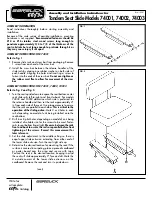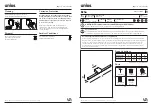
WCB11070 (PDF FORMAT)
13
©
Copyright Eaton Corp. 2007, All Rights reserved.
4.2.1.1
Single Disc Units
Apply approximately 25 PSIG (1.7 bar) air pressure to
the cylinder to engage the tensioner. Measure the "X"
gap between the cylinder (19) and the pressure plate
(13) or the gap "Y" between the pressure plate (13)
and the mounting flange (2) as shown in
Figure 7
. If
either gap exceeds the limits shown in Table 10, the
friction discs and/or wear plates must be inspected to
ensure that the wear limits listed in Table 13 have not
been exceeded.
4.2.1.2
Multi - Disc Units
Apply approximately 25 PSIG (1.7 bar) air pressure to
the cylinder to engage the tensioner. Measure the gap
"X" between the cylinder (19) and the pressure plate
(13) to determine if adjustment may be required.
Measure the "Y" gap between the pressure plate (13)
and the reaction plate (31), the "Y" gap between the
reaction plate (31) and the mounting flange (2), and
the "Z" gap between the reaction plates (31) as shown
in Figures 8, 9 and 10.
If the "X worn" dimension has been reached or
exceeded and the "Y" or "Z" dimensions have not
reached the limits shown in Table 10
AND
none of the
friction discs are worn to the bottom of the wear
groove / step, wear adjustment is required. It is also
recommended that wear plates be inspected to ensure
that the wear limits listed in Table 13 have not been
exceeded.
If wear adjustment is not made, the piston
may extend out of the cylinder beyond an
acceptable operating range, resulting in loss
of torque and/or seal damage.
If the "Y" or "Z" dimensions have been reached or any
of the friction discs are worn to the bottom of the wear
groove (or step), the tensioner should be taken out of
service and rebuilt with new components as required.
4.2.2
Adjustment Procedure
Wear adjustment can be conducted without full disas-
sembly of the WCB2 tensioner. The wear adjustment
spacers are slotted to allow for easy removal with a
chisel.
Figure 6
Before performing any maintenance work on
the WCB2 unit, make sure that the machinery
will remain in a safe position. Failure to do so
could result is serious injury or possibly
death.
Note :
It may be necessary to disconnect air and
water supply lines to prevent damage to the hoses
and binding of components during the adjustment pro-
cedure.
4.2.2.1 Wear spacers should be removed in complete sets
only (one from each stud location). Mark the spacers
to be removed to avoid confusion during removal.
Removal of spacers in quantities other than
complete sets (layers) will result in severe
damage to WCB2 components during re-
assembly, and could cause the brake to not
function properly.
4.2.2.2 If so equipped, remove the support bracket from the
cylinder (19) end of the unit.
4.2.2.3 Loosen the locknuts (18) evenly (ONE TURN AT A
TIME) and in an alternating (cross wise) pattern to
prevent binding of the cylinder on the studs. Continue
to loosen the locknuts until the force of the release
springs is relieved, allowing for access to the wear
spacers. It may be necessary to push the pressure
plate and reaction plate(s) away from the mounting
flange so that the release springs can be moved to
gain access to the wear spacers.
Dust / Wear
Grooves
















































